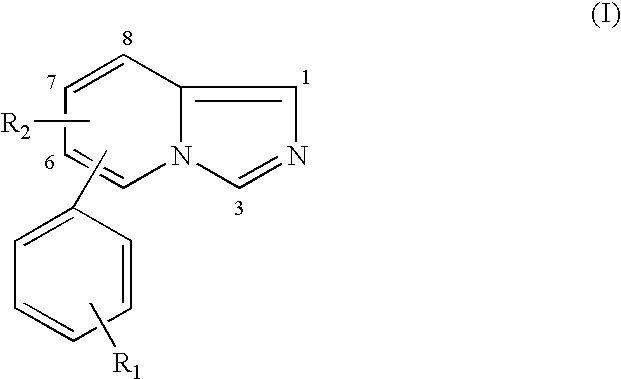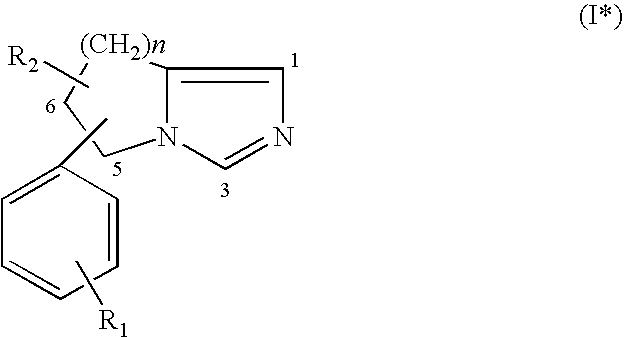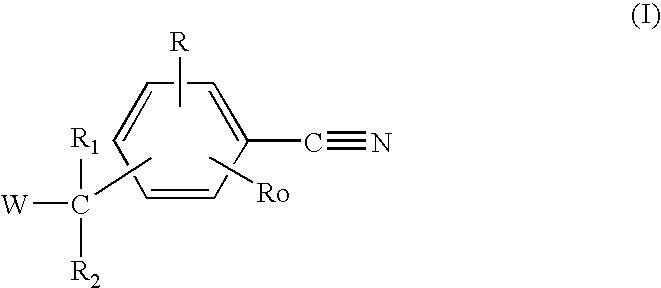Aromatase inhibition to enhance assisted reproduction
a technology of aromatase and inhibition, which is applied in the field of treatment of females, can solve the problems of affecting the outcome of infertility treatment, affecting the uterine receptivity, and jeopardizing the chance of implantation, and achieves the effect of reducing the amount of such inhibitors
- Summary
- Abstract
- Description
- Claims
- Application Information
AI Technical Summary
Benefits of technology
Problems solved by technology
Method used
Image
Examples
example 1
[0340]This was a prospective controlled study that included a study group, the patients of which received letrozole (2.5 mg / day from (day 3 to 7 of the menstrual cycle) in addition to FSH and a control group that received FSH only. The study group included 12 unexplained infertility patients. The control group-consisted of 55 unexplained infertility patients. All patients received recombinant or highly purified FSH (50-150 IU / day starting on day 3 to 7 until day of hCG (10,000 IU) that was given when 2 leading follicles were >2 cm). The FSH regimen was based on the patient's clinical profile. Patients were not randomized. All patients had intrauterine insemination. There was no statistically significant difference between the study and control groups as regards age, weight, infertility duration, number of prior insemination cycles, semen parameters or type of FSH.
[0341]The FSH needed was statistically significantly lower when letrozole was used in both study group compared with the ...
example 2
[0343]Fifteen patients who either failed to ovulate (6 cycles) or ovulated with an endometrial thickness <5 mm (24 cycles) in response to CC and who did not conceive were given letrozole orally, at least two months after the last CC cycle, in a dose of 2.5 to 5 mg / day, from day 3 to 7 or 5 to 9 of the menstrual cycle. HCG 10,000 IU was given to trigger ovulation. CC was given in a dose of 50-100 mg on days 3-7 or 5-9.
[0344]Fifteen patients completed 17 letrozole cycles. Ovulation occurred in 13 cycles (77%) and pregnancy in 5 out of 15 patients (33%). The following table shows summary of CC and letrozole cycles.
[0345]
TABLE 2MeanRangeMedianTreatmentLetrozoleCCPLetrozoleCCLetrozoleCCDay of hCG14.512.6S11-1811-161512administrationNumber of Days from6.74.4S2-92-774last letrozole tabletto hCG dayEndometrial Thickness0.80.5S0.6-1.10.4-0.80.80.4(Cm.)Follicles > 1.5 Cm2.41.9NS1-31-522on day of hCGadministrationEstradiol (pmol / L)10162145S 107-2347 362-52109011668on day of hCGadministrationEs...
example 3
[0347]This example demonstrates the effect of letrozole alone in a single dose form of administration. The estradiol levels in 9 treatment cycles in 7 infertile patients (3 with PCOS and 4 with unexplained infertility) undergoing ovarian stimulation and cycle monitoring for IUI who received a single 20 mg dose of letrozole on day 3 of the cycle. Follicle development was monitored by transvaginal ultrasound and by serum levels of estradiol and LH. Pregnancy was achieved in one patient. The mean estradiol level on the day of hCG was 831 pmol / L and the mean estradiol level per mature follicle was 390 pmol / L, almost exactly the same as seen with a 5-day daily dose of letrozole illustrated in the previous example.
[0348]
TABLE 3Letrozole single-dose cyclesDay of hCG administration 12.9 (2.9)Endometrial thickness on hCG 0.9 (0.11)day (cm)Follicles > 1.5 cm 2.29 (1.3)Estradiol on hCG day (pmol / L)831 (359)Estradiol / mature follicle390 (74)(pmol / L)LH (IU / L) 19.1 (12.7)
PUM
| Property | Measurement | Unit |
|---|---|---|
| Thickness | aaaaa | aaaaa |
| Mass | aaaaa | aaaaa |
| Mass | aaaaa | aaaaa |
Abstract
Description
Claims
Application Information
 Login to View More
Login to View More - R&D
- Intellectual Property
- Life Sciences
- Materials
- Tech Scout
- Unparalleled Data Quality
- Higher Quality Content
- 60% Fewer Hallucinations
Browse by: Latest US Patents, China's latest patents, Technical Efficacy Thesaurus, Application Domain, Technology Topic, Popular Technical Reports.
© 2025 PatSnap. All rights reserved.Legal|Privacy policy|Modern Slavery Act Transparency Statement|Sitemap|About US| Contact US: help@patsnap.com



